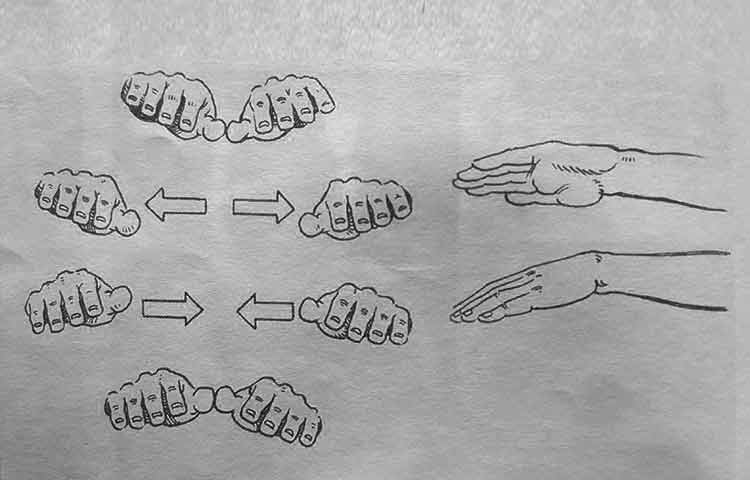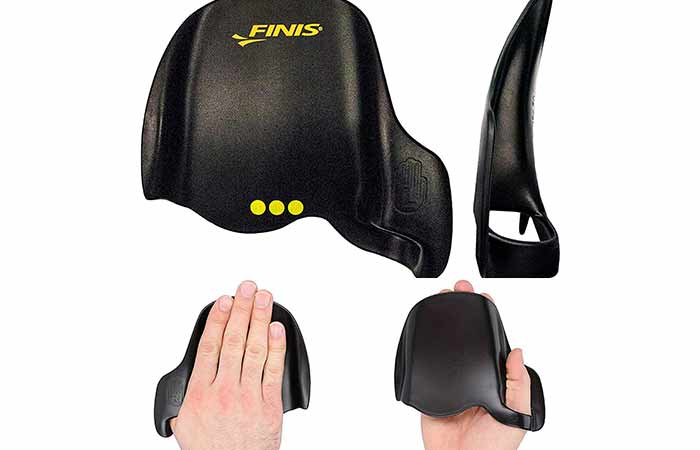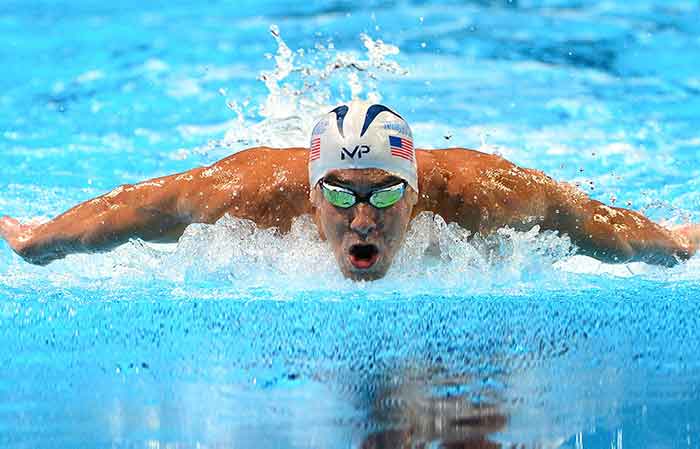What is Sculling in Swimming? How to do it + Drills & Benefits
Your hands play an important role in water. They act as paddles. When placed in an ideal position and with certain movements in water, your hands can lift you up, move you forward, backward, or sideways. The whole idea of using your hands in swimming is referred to as sculling. It basically allows you to feel the water and act accordingly.
While sculling is mostly combined with certain leg kicks to help you float with your head above the surface of the water, this hand skill is vital in improving your swimming technique, as its fundamentals are at the core of most swimming strokes and water sports.
Read on to find what exactly sculling is, how to scull properly, types, why it is important, drills and exercises to improve your technique.
What is Sculling in Swimming?
In swimming, sculling is moving your hands in different directions and at certain angles to maximize surface area for effective propulsion and lift.
This hand skill lets swimmers and other water sports players feel the water pressure, by focusing on the pitch or angle of the hands in the water. The pitch dictates your direction and speed in the water.
Learning how to scull properly develops your sensitivity to the water in your palms. This helps you understand when and where to apply pressure during the strokes.
While the most common variation of sculling is the one where the upper body is in a vertical position with the head above the surface of the water, there are other sculling types including, horizontal, head first, feet first and front/or catch. All these variations depend on the desired stroke and the outcome of the stroke.
How to Scull Water-Vertical
Because sculling is a hand skill, the orientation of the palms matters a lot. It is all about the angle and direction of your hands. You also need to relax as much as possible. Keeping that in mind, the following are the steps to scull while in an upright position.
- Get into the shallow end of the pool. Find a depth where you can keep your head above water whilst you kneel.
- With your head and part of the neck just above the water, extend out your arms to the side to a horizontal plane.
- While on the horizontal plane, move your forearms inwards towards your front without touching. The palms should face forward, tilted at about 45 dgrees, with your thumbs a little up.
- Still maintaining the horizontal plane, move the arms backwards as much as you’re comfortable doing. As you move the hand out, tilt the palms, such that they face out, slightly downwards, at about 45 degrees, your pinky fingers a little up.
- Repeat the inward and outward movements enough to raise your knees off the bottom.
- Once you can comfortably float in the shallow water, you advance to the deep of the pool. Have your feet directly underneath you, toes pointing straight down, then start the sculling action.
- To float for longer periods, combine the sculling motion with leg kicks (treading water) to increase your buoyancy.

Tips
- Turn your palms in the direction that your arms are moving.
- Keep your back straight. Don’t lean forward or backward.
- Do not move your palms up and down.
- Vary the width of your stroke: sometimes let your hands stay far apart, and sometimes let them almost touch.
Other Types of Sculling & Drills.
Practicing various types of sculling generally helps you feel the pressure of the water. This makes it easier to assess the changes and improvements you need to make to avoid fatigue, tension, and poor stroke mechanics.
Head First
This variation of sculling involves moving headfirst through the water. To perform a head-first sculling follow the steps below
- Float on your back.
- Hold your arms straight and close to your sides.
- Bend your wrists backward so your fingertips are pointing up and your palms are facing your feet.
- Start the back and forth sweeping motion with your hands to propel your body backward.
Horizontal
This is an immobile sculling technique that can be done face up or face down. To scull face up, simply float on your back with your arms straight by your sides. Begin the in and out sweeping motion with your hands.
Unlike the vertical technique, the sculling motion begins from your shoulders, passes through your forearms and then to your hands. Keep your arms close to your body and apply some downward pressure with your palms.
To scull face down, take a deep breath and lie horizontally, face down in the water. Hold your arms the same way you did with the vertical technique and sweep your hands in a similar way. A pull buoy between your legs and a snorkel makes this a lot easier.
Feet First
This variation is designed to improve the performance of the forearm for all stages breaststroke, freestyle, backstroke or butterfly.
To do the feet first scull, float horizontally on your back. Relax your body so that your knees bend slightly and your neck is relaxed. Hold your arms straight and close to your sides. Bend your wrist down so your fingertips are pointing toward the bottom of the pool. Instead of a figure eight sweep, it’s more circular, more like a breaststroke pull.
Most of your movement will come from the forearms as your hands scull no more than 10 inches from your hips.
Catch Scull
The catch scull uses the high elbow combined with the forearm and hands to produce frontward propulsion. It is an ideal drill for swimmers who want to improve the catch stage of the front crawl in freestyle. It is good for developing your arms.
To do the front catch scull, put your arms out in front of you and bend your elbows. You should lie face down in the water and put a buoy between your legs. If you don’t have a buoy, use small flutter kicks to avoid sinking.
Make sure your elbow is above your hand and your fingertips tilt toward the bottom of the pool.
The movement must come from the forearms and the hands and not the shoulders. Add hip rotation to minimize shoulder strain as well as improve form.
Front Scull
In this variation, the hands are far in front of you like in the superman position. The wrists and hands perform the sculling.
Float horizontally on your stomach, your face in the water. Put your arms out in front of you and place your face in the water. Initiate forward propulsion by moving the wrists and hands in a side-to-side motion to propel your body through the water.
From the front scull, you can change into Wide-Y Sculling by, scull out to the Wide-Y position and then bringing your arms back in front. Do not bend your elbows.
The Importance of Sculling
Among the reasons you need to know how to properly scull water include the following:
For Survival
Sculling is an important part of water-treading as it’s the most efficient when it comes to staying afloat and saving on energy. As part of the treading water technique, it helps you keep your head above the water for a long time as you’ll be using little energy to stay afloat.
When is swimming in deep water, you can also use sculling to stay afloat if you happen to get leg muscle pulls or foot cramps. You can use your arms only to relax or even stretch your legs.
An essential skill for Water Polo and Synchronized Swimming
Sculling is one of the core skills every water polo player or artistic swimmer has to master. In water polo, sculling is used to jump and throw the ball while in synchronized swimming it is use to hold your legs up while floating in the water.
Corrects Your Technique
When you take time to go through all the motions of sculling, you’ll find out which part of your stroke is the weakest and which one is the strongest. This helps you correct the poor parts while improving on the weaker ones. Better yet, you’ll learn how to correctly move your hands during the strokes of your favorite swimming style.
You do that by sculling while focused on how the water feels against your hand. With time, you’ll find out what part of the scull is your best.
Makes Your Catch Better
When sculling, your hands are horizontal and your palms face in front of you. In this way, your hands will be performing a catch as they move forwards. It’s a great opportunity to learn how to have a better catch in this position given that there’s little resistance.
The fact that the hands don’t come out of the water when moving against the palms makes it tough since for most strokes the arm recovers out of the water and without the resistance of water. You thus become better at generating force with the inside of your palm and reducing resistance with the outside of the same hand.
Improves Your Feel for the Water
Swimmers understand the need to feel the water since that’s when you’re most in control. Feeling the water is important as it helps you avoid unnecessary drag and instead focus on gaining speed and being better at your stroke.
Developing a feel for the water takes time and one way to learn that is through slow techniques such as sculling and treading water. This way, you’ll feel how water acts when you’re moving. You can thus accurately move around the water in terms of the force you apply and the speed you gain.
Helps Reset Your Stroke
When you’re swimming and you realize your stroke isn’t at its best, the solution isn’t continuing with it but resetting and starting afresh. Rather than stopping and getting out of the water, you simply stop the stroke, scull for a while then start the right way.
This is used even during coaching lessons where you’re told on how to correct your form without the need to get out of the water. Essentially, it’s a form of break that still keeps you in line with your swim.
Prevents Shoulder Injuries
When sculling, you’re basically working the shoulders as your hands will be on a horizontal level. The motion of the rest of the hand depends on the strength of the shoulders. Sculling helps you develop stronger shoulders as you have better control of the arms.
Besides that, sculling helps you determine how far back your arms can move. Slowly, your mind gets to learn how far you can stretch the shoulders during a normal swimming stroke.
These aspects are vital whether you’re swimming for fun or competitively.
Sculling Exercises & Tips
Stretching, and other exercises that involve your palms and arms, such as push-ups, are great for sculling.
For a proper sculling form, consider the following tips:

- To more make your sculling more effective, try out sculling-assistive devices like the FINIS Instinct strapless sculling paddle. These paddles are designed to teach the appropriate thumb and palm position during sculling drills.
- Avoid pulling on the water. Instead, naturally move the arms in the water.
- Have your fingers slightly apart and hands slightly cupped especially when sculling face up or down in horizontal position.
- When combing your sculling with leg kicks, ensure you maintain up the rhythm of the hands. Given that most water treading techniques have different motions for the legs and the hands, coordinating may be a problem.
- You can learn the sculling techniques out of the water, understand how it is done, visualize and do it without water
- Keep your focus on the hands and palms to make the most of it.
- Try to maintain an upright position for vertical scull and a streamlined position for horizontal variations.
- Breath naturally to dissipate any tension and stiffness that may mess up your technique.
- Keep the strokes slow and natural and avoid speed.
- Practice makes perfect- It may take you several hours, days or months to master the art of sculling. Do not give up keep on practising consistently and persistently
Further Reading
Following is a list of articles with more swimming information and other water sports
Swimming Strokes/Styles
- Different Types of Swimming Strokes, Styles & Names
- How to Tread Water- Techniques, Benefits & Exercises
- How to Swim Freestyle: Technique, Tips & Drills
- How to Swim Breaststroke: Kick, Pull, Form, Drills & Tips
- Butterfly vs Breaststroke Swimming
- How to Swim Elementary Backstroke- Technique, Drills & Tips
- How to Swim Sidestroke-Technique,Trudgen &Combat Drills & Tips
- How to Swim Backstroke-Technique, Drills & Tips
- How to Swim Butterfly: Technique, Drills & Tips
Swimming FAQs & Ideas
- How Many Calories Does Treading Water Burn?
- Can you Swim with Contacts in the Ocean/Pool?
- Can you Open your Eyes in the Salty Ocean or Chlorinated Pool Waters?







